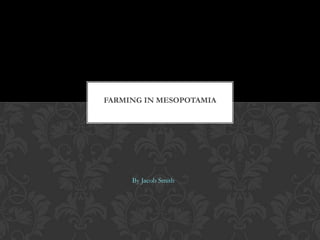
Farming in mesopotamia
- 1. FARMING IN MESOPOTAMIA By Jacob Smith
- 2. TABLE OF CONTENTS Farmers decide when to let water flow……………………………………page 3 Farmers let animals graze in the fields……………………………………page 4 Farmers use hand tools to break up soil…………………………………page 5 Farmers plowed and spread seeds……………………………………….page 6 Farmers plant seeds………………………………………………….……page 7 Famers harvest the crops…………………………………………………page 8 Farmer prepare the food………………………………………………….page 9
- 3. LOCAL OFFICIALS DECIDE WHEN TO LET WATER FLOW ONTO THE CROPS In Mesopotamia there were two major rivers. The rivers often flooded the crops. Also there was little water during the fall months. So the Mesopotamians built canals. The official decided when to open gates to let water on the crops. These gates were really affective in helping the plant grow. page 3
- 4. FARMERS LET ANIMALS GRAZE IN SOIL TO TRAMPLE AND EAT WEED Farmer would let the animals into the fields to eat weeds. The animals would trample and eat the weeds. This helped because the weeds would kill the crops so when the animals killed them it made it easier for the crops to grow. The animals would get fed and the fields would be ready for crop. This way it helped all the living things (except the weeds). page 4
- 5. FARMERS BREAK UP THE SOIL USING HAND TOOLS Farmers had to use hand tools to get the fields ready. They used these tools to break up the soil. Some of the tools the farmers use were big, and Some of these tools were small. Some examples of larger ones were the garden hoe, the shovel and the rake. These tools were used for making holes in the ground or turning the soil. This was useful for when they were getting ready to plan seeds. page 5
- 6. FARMERS SPREAD SEEDS AND PLOW The Mesopotamians had to dig holes and put each seed in one by one. Then they invented the seeder plow. The seeder plow was a plow that made planting seeds a lot less time consuming. It turned over the ground as you put seeds in a funnel, and then as they pulled it planted seeds and turned the ground back over the seed. This method proved more effective than there last. page 6
- 7. FARMERS PLANT SEEDS Before the seeder plow farmers planted seeds one by one. This took up lots of time and effort. They had to use hand tools to break up the soil (slide 5). They also used the tools to dig holes. After making small holes they planted seeds and covered the holes back up. page 7
- 8. FARMERS HARVEST THE CROPS After the crops were planted and grown the farmers went out to harvest. the farmers gathered everyone to help gather the crops. This took many hours to do. This was one of the longest processes they had. This was an important process because if you didn’t harvest there would be no food. page 8
- 9. FARMERS PREPARE THE FOOD After farmers harvested crops they made the food. People usually only had 2 meals unless they were wealthy. This was the process that took the least amount of time. It was a process involving cooking. Because they did not have electricity they had to use things like stone ovens. This was also a very important process because without food no one would survive. page 9